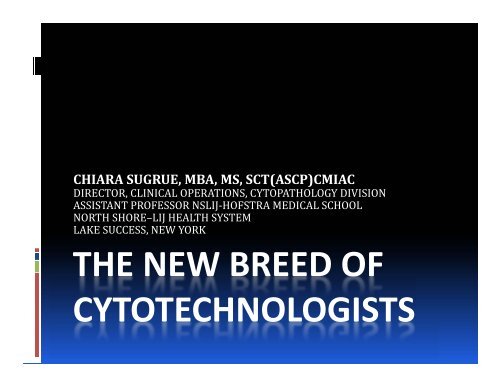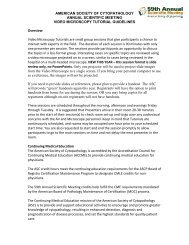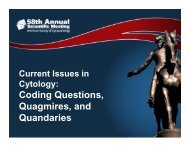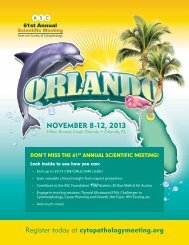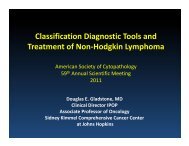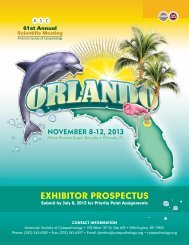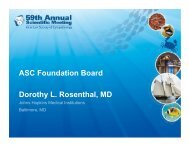Chiara F. Sugrue, MBA, MS, SCT(ASCP)
Chiara F. Sugrue, MBA, MS, SCT(ASCP)
Chiara F. Sugrue, MBA, MS, SCT(ASCP)
You also want an ePaper? Increase the reach of your titles
YUMPU automatically turns print PDFs into web optimized ePapers that Google loves.
CHIARA SUGRUE, <strong>MBA</strong>, <strong>MS</strong>, <strong>SCT</strong>(<strong>ASCP</strong>)CMIAC<br />
DIRECTOR, CLINICAL OPERATIONS, CYTOPATHOLOGY DIVISION<br />
ASSISTANT PROFESSOR NSLIJ‐HOFSTRA MEDICAL SCHOOL<br />
NORTH SHORE–LIJ HEALTH SYSTEM<br />
LAKE SUCCESS, NEW YORK<br />
THE NEW BREED OF<br />
CYTOTECHNOLOGISTS
I have nothing to disclose<br />
2
EXTENDED ROLE OF CYTOTECHNOLOGISTS<br />
1. Screening and interpretation: Gyn, Non‐Gyn, FNA<br />
• Screening IHC<br />
2. FNA Adequacy Assessment: superficial, CT scan, EBUS, EUS<br />
• Ultrasound assistance<br />
• Effective communication with clinicians<br />
3. Quality control/assurance<br />
4. Molecular testing: HPV, EGFR<br />
5. FISH: Urovysion<br />
6. Circulating Tumor Cell Testing<br />
7. Grossing<br />
8. Education, as part of the academic team in Pathology<br />
Residency & Cytopathology Fellowship<br />
3
FNA Rapid On‐Site Assessment of Adequacy<br />
(FNA ROSA) performed by Cytotechnologists<br />
STAKEHOLDERS<br />
• Patients<br />
• Laboratory Professionals<br />
• Laboratory Administrators<br />
• Medical Specialists (Radiology , ENT, Oncology, etc)<br />
• Payers<br />
4
FNA Rapid On‐Site Assessment of Adequacy<br />
(FNA ROSA) performed by Cytotechnologists<br />
ADVANTAGES<br />
• Allows appropriate specimen triage<br />
• IHC, Flow cytometry, Microbiology, Tissue bank for<br />
microRNA,<br />
• Reduces cost of patient care<br />
• Decreases number of unsatisfactory specimens<br />
• Decreases number of unnecessary surgery<br />
• Improves communication with clinicians<br />
• Allows better collection of clinical history<br />
• Brings the lab to the patient<br />
• “It is the right thing to do for the patient”<br />
5
Brigham & Women’s Hospital Cancer Cytopathology 2011<br />
Results<br />
• The accuracy of on‐site adequacy evaluation by<br />
Cytotechnologists = 93.2% to 96.5%.<br />
• The number of FNA on‐site adequacy evaluation increased<br />
annually by 11% on average (2003‐2009)<br />
6
FNA Rapid Onsite Assessment of Adequacy:<br />
The Experience of an Academic Institution<br />
Gobara N, Liang L, Wasserman P, Morgenstern N, <strong>Sugrue</strong> C<br />
North Shore‐LIJ Health System (Poster # 116 ‐ ASC 2011)<br />
Results<br />
• The accuracy of on‐site adequacy evaluation by<br />
Cytotechnologists = 94.8% to 95.9%<br />
• The number of FNA on‐site adequacy evaluation increased<br />
cumulatively by 59% (2008‐2010) ‐ by 49% for 2011<br />
7
North Shore-Long Island Jewish Health System Hospitals<br />
<br />
NSUH-Glen Cove<br />
<br />
<br />
<br />
Huntington Hosp<br />
<br />
<br />
<br />
<br />
Lenox Hill<br />
<br />
NSUH-Forest Hills<br />
Bayside<br />
<br />
<br />
<br />
NSUH-Manhasset<br />
CORE<br />
LIJ Jewish Med Ctr<br />
Med Ctr<br />
Franklin Hospital<br />
<br />
NSUH-Syosset<br />
<br />
NSUH-Plainview<br />
<br />
Southside Hospital<br />
<br />
<br />
SIUH-Concord<br />
<br />
SIUH North<br />
<br />
<br />
Peninsula Hospital<br />
SIUH South<br />
<br />
Prepared by NSLIJHS Planning Office, 1/10/02
FNA TEAM @ NSLIJHS Laboratories<br />
From left:<br />
Ryan Brenkert, Xin Ding, Sean McNair, James Rankin, Constantinos Coutsouvelis,<br />
Daniel Soto, Karen Chow, Antoinette Lugo<br />
9
It is evidence‐based knowledge that…<br />
Cytotechnologists are highly competent<br />
in performing FNA Rapid On-site<br />
Assessment of Adequacy<br />
10
FNA Rapid On‐Site Assessment of Adequacy<br />
(FNA ROSA) performed by Cytotechnologists<br />
DISADVANTAGES<br />
• Lab productivity loss<br />
• Inadequate service compensation<br />
• Lack of CPT codes for service by Cytotechnologists<br />
11
DISADVANTAGE<br />
Lab productivity loss<br />
1. Time average for FNA ROSA = 45‐60’<br />
(excluding traveling time). Duration influenced by:<br />
Specimen types<br />
Nature of the lesion<br />
Type of procedure (EBUS, EUS, CT scan)<br />
Operator experience<br />
2. Time away from screening<br />
12
Lab productivity loss: example<br />
Specimen Type CPT code Medicare<br />
Rate for NY<br />
(TC)<br />
Pap test<br />
(LBP)<br />
Pap test<br />
(w/Imaging)<br />
Urine<br />
(LBP)<br />
Case/hour<br />
Total<br />
Reimbursement<br />
88142 $ 28.51 10 $ 285.10<br />
88175 $35.06 10 $350.60<br />
88112 $ 59.07 9 $ 531.63<br />
FNA 88173 $ 88.60 2.5 $ 221.50<br />
Average<br />
per hour<br />
$ 347.21<br />
Average lab reimbursement for 1 hour<br />
Cytotechnologist screening work = $347.21<br />
13
Lab productivity loss: example cont.<br />
Loss of screening productivity = ($ 347.21)<br />
FNA reimbursement (CPT 88173) = $ 165.19<br />
Lab productivity loss for<br />
7<br />
www.cms.hhs.org<br />
14
DISADVANTAGE:<br />
Inadequate service compensation<br />
CPT code<br />
Medicare Rate<br />
for NY<br />
(TC)<br />
Note<br />
88172TC $10 Supplies<br />
88177 N/A Each additional<br />
evaluation episode<br />
15
Additional considerations:<br />
Reduced lab reimbursement in near future<br />
• Do more with less<br />
Improve efficiency<br />
Increase financial performance<br />
Expand quality measures, decrease TAT<br />
• Challenges in shifting Cytotechnologists’ billable to<br />
non‐billable services<br />
• Do the right thing for the patient<br />
16
• New ways to apply technology<br />
• New ways of looking at multidisciplinary<br />
collaborations<br />
• New ways for continuing to provide value to<br />
the patients and to the lab<br />
Business as usual is not an alternative<br />
17
Option 1:<br />
Adoption of Telepathology<br />
• Increasingly implemented for direct patient care<br />
• 2007 CAP – General Checklist<br />
<br />
<br />
<br />
Primary diagnosis<br />
Frozen sections diagnosis<br />
Formal second‐opinion consultations<br />
• 2010 CAP ‐ Anatomic Pathology Checklist added Digital<br />
Image Analysis section<br />
DNA , Morphometric analysis, FISH<br />
• FNA on‐site adequacy assessment<br />
<br />
<br />
<br />
<br />
Absence of specific regulation and practical guidelines<br />
Validation required for the intended use<br />
Initial capital expense<br />
Dependent on 2 operators<br />
18
Telepathology validation<br />
at NSLIJHS Laboratories<br />
19
Option 2:<br />
Conversation with Medical Specialists<br />
• Can we share the responsibility of hiring a<br />
Cytotechnologist<br />
CYTOPATHOLOGY<br />
) Provide Training<br />
Competence<br />
Performance Appraisal<br />
Continuing Education<br />
MEDICAL SPECIALISTS (i.e. RADIOLOGY)<br />
Provide<br />
Salary & Benefit<br />
20
Option 3:<br />
Propose a new CPT code for FNA ROSA<br />
performed by Cytotechnologists<br />
CTs have enormously expanded the scope of service<br />
in the last decade & acquired highly specialized skills<br />
Master ‐ Cytotechnology programs<br />
Shortage of Pathologists in the US<br />
• Delegation of routine work to Cytotechnologists and<br />
Pathology Assistants<br />
21
Propose a new CPT code for FNA ROSA<br />
performed by Cytotechnologists cont.<br />
• Accepting the reimbursement system as<br />
immutable is not in the profession best interest<br />
• Changes in AMA recommendation and C<strong>MS</strong><br />
approval will require hard work<br />
• When Pathologists and Cytotechnologists work<br />
as team better outcome better<br />
patient care<br />
• As professional organization, we should become<br />
the agent of change.<br />
22
New model for FNA rapid on‐site<br />
Assessment of Adequacy by Cytotechnologists<br />
• Brings the lab to the patient<br />
• Adds value to the lab<br />
Holistic pursuit<br />
• Maintains lab presence in the patient‐centered<br />
team<br />
• Creates an institutional logic<br />
THANK YOU<br />
23
References<br />
• Burlingame OO, Kesse’ KO, Silverman SG, Cibas ES. On‐Site Adequacy Evaluation performed by Cytotechnologists: Correlation with final<br />
Interpretation of 5241 image‐guided Fine Needle Aspiration Biopsies. Cancer Cytopathol. 2011.<br />
• Eedes CR, Wang HH. Cost‐effectiveness of immediate specimen adequacy assessment of thyroid fine‐needle aspirations. Am J Clin Pathol. 2004;<br />
121: 64‐69<br />
• Nasuti JF, Gupta PK, Baloch ZW. Diagnostic value and cost‐effectiveness of fine‐needle aspirations specimens: review of 5,688 cases. Diagn<br />
Cytopathol. 2002; 27: 1‐4<br />
• Andonian S. Okeke Z. Okeke DA, <strong>Sugrue</strong> C, Wasserman PG, Lee BR. Number of needle passes does not correlate with the diagnostic yield of<br />
renal fine needle aspiration cytology. J Endourol. 2008; 22: 2377‐2380.<br />
• Alsohaibani F, Girgis S, Sandha GS. Does onsite Cytotechnology evaluation improve the accuracy of endoscopic ultrasound‐guided fine‐needle<br />
aspiration biopsy Can J Gastroenterol. 2009;23: 26‐30<br />
• Layfield LJ, Bentz JS, Gopez EV. Immediate on‐site interpretation of fine‐needle aspiration smears: a cost and compensation analysis. Cancer.<br />
2001; 93: 319‐322.<br />
• Gupta PK. Progression from on‐site to point‐of‐care fine needle aspiration service: Opportunities and challenges. CytoJournal. 2010; 7:6<br />
• Dhillon I, Pitman MB, DeMay RM, Archuletta P, Shidham V. Compensation crisis related to the onsite adequacy evaluation during FNA<br />
procedure. Urgent proactive input from Cytopathology community is crucial to establish appropriate reimbursement for CPT code 88172 (or<br />
its new counterpart if introduced in the future). CytoJournal 2010; 7:23<br />
• Al‐Abbadi MA, Bloom LI, Fatheree LA, Haack LA, Minokowitz G, Wilbur DC, Austin MR. Adequate reimbursement is crucial to support costeffective<br />
rapid on –site Cytopathology evaluations. CytoJournal 2010; 7:22<br />
• Davey DD, Neal MH. Coding charges in the United States front and center: Implications for Cytopathology. Cancer Cytopathol. 2011.<br />
• Ghofrani M, Beckman D, Rimm DL. The value of onsite adequacy assessment of thyroid fine‐needle aspirations is a function of operator<br />
experience. Cancer Cytopathol. 2006; 108: 110‐113.<br />
• American Medical Association. Pathology and Laboratory. In CPT ® (Current Procedural Terminology) 2011 Professional Edition. Chicago:<br />
American Medical Association; 2010: 433‐435.<br />
• US Department of Health and Human Services, Center for Medicare and Medicaid Services. 2011 MLN Matters Articles, MM7727.<br />
http://www.cms.gov/MLN‐MattersArticles/2011Mman.<br />
• Zhu W, Michael CW. How important is onsite adequacy assessment for Thyroid FNA: An evaluation of 883 cases. Diagn Cytopathol. 2007;35:<br />
183‐186.<br />
• Woon C, Bardales RH, Stanley MW, Stelow EB. Rapid Assessment of fine needle aspiration and final diagnosis: How often and why the<br />
diagnoses are changed CytoJournal 2016; 6:25.<br />
24


